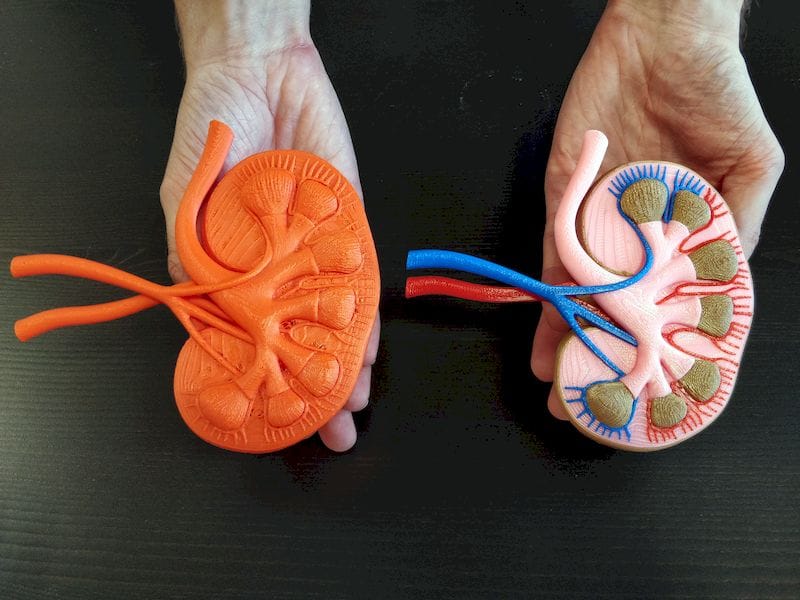![The new Palette 2 produces incredibly detailed multi-material prints, on the right [Source: Mosaic Manufacturing]](https://fabbaloo.com/wp-content/uploads/2020/05/image-asset_img_5eb0a93a37c8a.jpg)
Mosaic Manufacturing announced their latest 3D printing product, the Palette 2.
If you’re not familiar with the original Palette and Palette+, you should be, as they are among the most unique 3D printer accessories one could consider using. They can literally change a single extruder desktop 3D printer into a multi-material machine – without altering the printer in any way.
Their concept actually sounds a bit crazy, but in fact it actually works: Their software analyzes the GCODE for 3D printing a multi-material 3D model and on the fly creates a custom filament by assembling different-length segments of separate base filaments.
Wait, let’s try explaining that again: They splice bits of filament together such that when each segment comes out of the nozzle it is timed precisely to match the material requirements for that particular section of the 3D model. The filament generated would make little sense to the eyes, as it would appear to be a strand of random colors. It all comes together upon extrusion.
It would appear to be an impossible achievement to somehow coordinate all the activity in such a way to allow for a successful 3D print, but they’ve done it years ago. The resulting machine, the Palette (and later Palette+) simply act as an accessory. While your single-extruder desktop 3D printer merrily extrudes what it believes to be a single incoming filament, it’s actually performing multi-material extrusion. The Palette sits beside the 3D printer and accepts up to four input filaments to create one output filament that feeds the 3D printer.
There are a couple of interesting twists in their concept. For example, one could use water-soluble support in one of the input filaments, thus making it possible for a single extruder desktop 3D printer to successfully 3D print very complex geometries, which otherwise would likely fail.
Another interesting twist is to load all four inputs with the same material. That way when the filament runs out on one spool, it can be switched to another spool, creating a “virtual spool” of 4X the capacity.
And with all this you don’t need to make ANY changes to your desktop 3D printer; Just feed it the filament from the Palette.
So you see the Palette is a fascinating concept.
But now they have announced the Palette 2. What is different in this model?
We asked Mosaic Manufacturing and were told that the new device is more capable of integrating into a 3D printer than its predecessors.
The previous Palettes would track the print activity by carefully monitoring the “pull” of filament from the printer by observing the state of rotary encoders. They would be able to at least attempt to keep in sync with the printer by doing so. Not keeping in sync would mean the different colors or materials would appear in the wrong places in the print.
The new Palette 2 integrates directly with a 3D printer, literally controlling its movements through the direct delivery of GCODE instructions. This is a far more effective method of integrating with the printer and should enable superior synchronization of filament and extrusion.
It seems that in order to accomplish an “integration”, the Palette must have some awareness of the peculiarities of specific machines. That said, the company announced they are working on or have arrangements with several leading desktop 3D printer manufacturers to organize such integrations.
So far they list these companies as participants:
- MakerGear
- Raise 3D
- Dremel
- Robo
- GCreate
- MAKEiT
This is by no means the entire list of possible 3D printers. Indeed there are many notable companies not yet on the list, but I can imagine there are plenty of negotiations underway. One interesting partnership I could see having trouble here would be with Prusa Research. While that company is one of the leaders in production volume with many thousands of machines sold each month, they are also in the midst of developing their own solution to multi-material 3D printing and may shy away from the Palette to focus on their own solution.
One knock I had with the earlier Palettes was their price. They were priced as high as USD$999 each, a price point that would, in some cases, allow for the purchase of a multi-material 3D printer if the same funds were redirected. However, Mosaic Manufacturing seems to have realized this and they’ve dropped the price significantly on the Palette 2.
The new machine will hold a price of USD$599, with a launch price of only USD$499. That’s not a bad deal when considering it will literally change your device into the equivalent of a four-extruder machine.











